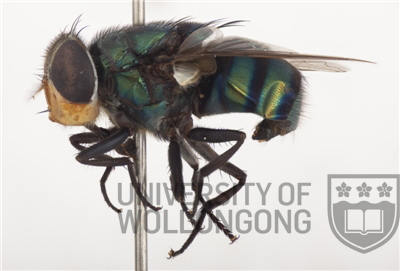Taxonomy
Family: Calliphoridae
Subfamily: Chrysomyinae
Genus: Chrysomya Robineau Desvoidy 1830
Species: megacephala (Fabricius 1794)
The first-instar larva was described by Sukontason et al. (2003) and Szpila et al. (2013). The second-instar larva was described by Erzinçlioglu (1984) and Sukontason et al. (2003), the third-instar larva by Holloway (1991), Erzinçlioglu (1984) and Sukontason et al. (2003).
Biology
Chrysomya megacephala is one of the most common members of the genus in Australia. It is a large species, often exceeding 10mm in length and is of tropical origin. It has been reported in forensic cases in Thailand, and in other developing countries, and has been responsible for causing myiasis in humans (Sukontason et al. 2005). Because it is readily attracted to garbage, it can also act as a vector of disease, and is therefore also of sanitary importance. Adults breed mostly in carrion, but they are also attracted to garbage and faeces. It has been bred by J. F. Wallman from human corpses in News South Wales and Queensland.
Larval development of Ch. megacephala has been investigated by O’Flynn (1983), Sukontason et al. (2008), Wells and Kurahashi (1994) and Wijesundara (1957). The species prefers the warmer months, and will completely disappear from some areas during winter. During summer, it may be the most abundant carrion-breeding blowfly in certain parts of its range.
It is morphologically similar to its sister species, Chrysomya saffranea, but can be distinguished by its black supravibrissal and subvibrissal setulae. Chrysomya megacephala and Ch. saffranea males have eyes with enlarged ommatidia in the upper two-thirds, however in Ch. megacephala the upper two-thirds are sharply demarcated from the smaller ones in the lower third, whereas they are not sharply demarcated in Ch. saffranea (see picture). To determine the gender of your fly click here.
Distribution
This species
is found across northern Australia and also occurs commonly
in south-east Asia. In Australia, it has been recorded from
the Australian Capital Territory, New South Wales, Northern
Territory, Queensland, South Australia and Western
Australia.
Relevant Literature
Erzinçlioglu, Y.Z. (1984) Studies on the
morphology and taxonomy of the immature stages of
Calliphoridae, with analysis of phylogenetic
relationships within the family, and between it and
other groups in the Cyclorrhapha (Diptera). Ph.D.,
University of Durham.
Holloway, B.A. (1991)
Identification of third-instar larvae of flystrike and
carrion-associated blowflies in New Zealand (Diptera:
Calliphoridae). New
Zealand Entomologist 14,
24-28.
Kurahashi, H.
(1987) The blow
flies of New Guinea, Bismark Archipelago and Bougainville
Island (Diptera: Calliphoridae),
Tokyo, The Entomological Society of Japan.
O'Flynn, M.A. (1983) The succession and rate of
development of blowflies in southern Queensland and the
application of these data to forensic entomology. Journal of the
Australian Entomological Society 22, 137-148.
Sukontason, K.L.,
Narongchai, P., Sripakdee, D., Boonchu, N.,
Chaiwong, T., Ngern-Klun, R., Piangjai, S. and
Sukontason, K. (2005) First report of human Myiasis
caused by Chrysomya
megacephala and Chrysomya
rufifacies (Diptera:
Calliphoridae) in Thailand, and its implications
in forensic entomology. Journal of
Medical Entomology 42,
702-704.
Sukontason, K., Piangjai, S.,
Siriwattanarungsee, S. and Sukontason, K.L. (2008)
Morphology and developmental rate of blowflies Chrysomya
megacephala and Chrysomya
rufifacies in Thailand: application in
forensic entomology. Parasitology Research 102,
1207-1216.
Szpila, K., Hall, M.J., Sukontason, K. and Tantawi, T. I. (2013)
Morphology and identification of first instars of the European and Mediterranean blowflies of forensic importance. Part I: Chrysomyinae. Medical and veterinary Entomology 27,
181-193.
Wells, J.D. and Kurahashi, H.
(1994) Chrysomya
megacephala (Fabricus) (Diptera:
Calliphoridae) development: rate, variation and the
implications for forensic entomology. Japanese
Journal of Sanitary Zoology 45,
303-309.
Wijesundara, D.P. (1957) The life history and bionomics of Chrysomyia megacephala (Fab.). Ceylon Journal of Science 25, 169-185.




